[English] 日本語
 Yorodumi
Yorodumi- PDB-7rmh: Substance P bound to active human neurokinin 1 receptor in comple... -
+ Open data
Open data
- Basic information
Basic information
| Entry | Database: PDB / ID: 7rmh | ||||||||||||||||||||||||||||||||||||
|---|---|---|---|---|---|---|---|---|---|---|---|---|---|---|---|---|---|---|---|---|---|---|---|---|---|---|---|---|---|---|---|---|---|---|---|---|---|
| Title | Substance P bound to active human neurokinin 1 receptor in complex with miniGs399 | ||||||||||||||||||||||||||||||||||||
 Components Components |
| ||||||||||||||||||||||||||||||||||||
 Keywords Keywords | SIGNALING PROTEIN/MEMBRANE PROTEIN / Substance P / G protein / GPCR / Neurokinin / Tachykinin / SIGNALING PROTEIN / SIGNALING PROTEIN-MEMBRANE PROTEIN complex | ||||||||||||||||||||||||||||||||||||
| Function / homology |  Function and homology information Function and homology informationsubstance P receptor binding / substance P receptor activity / positive regulation of corticosterone secretion / tachykinin receptor activity / positive regulation of flagellated sperm motility / aggressive behavior / Tachykinin receptors bind tachykinins / sperm ejaculation / positive regulation of uterine smooth muscle contraction / insemination ...substance P receptor binding / substance P receptor activity / positive regulation of corticosterone secretion / tachykinin receptor activity / positive regulation of flagellated sperm motility / aggressive behavior / Tachykinin receptors bind tachykinins / sperm ejaculation / positive regulation of uterine smooth muscle contraction / insemination / positive regulation of synaptic transmission, cholinergic / detection of abiotic stimulus / operant conditioning / positive regulation of lymphocyte proliferation / tachykinin receptor signaling pathway / response to ozone / sperm head / positive regulation of action potential / response to auditory stimulus / positive regulation of acute inflammatory response / positive regulation of blood pressure / smooth muscle contraction involved in micturition / regulation of smooth muscle cell proliferation / positive regulation of vascular permeability / positive regulation of hormone secretion / positive regulation of ossification / regulation of smooth muscle cell migration / positive regulation of leukocyte migration / eating behavior / negative regulation of heart rate / response to pain / positive regulation of vasoconstriction / behavioral response to pain / angiotensin-mediated drinking behavior / associative learning / positive regulation of epithelial cell migration / PKA activation in glucagon signalling / response to electrical stimulus / developmental growth / hair follicle placode formation / neuropeptide signaling pathway / long-term memory / D1 dopamine receptor binding / sperm flagellum / neuronal dense core vesicle / intracellular transport / vascular endothelial cell response to laminar fluid shear stress / renal water homeostasis / activation of adenylate cyclase activity / Hedgehog 'off' state / adenylate cyclase-activating adrenergic receptor signaling pathway / response to hormone / positive regulation of stress fiber assembly / sperm midpiece / sensory perception of pain / cellular response to glucagon stimulus / regulation of insulin secretion / response to progesterone / adenylate cyclase activator activity / trans-Golgi network membrane / positive regulation of epithelial cell proliferation / positive regulation of synaptic transmission, GABAergic / response to nicotine / negative regulation of inflammatory response to antigenic stimulus / cellular response to nerve growth factor stimulus / bone development / regulation of blood pressure / platelet aggregation / G-protein beta/gamma-subunit complex binding / cognition / Olfactory Signaling Pathway / Activation of the phototransduction cascade / G beta:gamma signalling through PLC beta / Presynaptic function of Kainate receptors / Thromboxane signalling through TP receptor / G protein-coupled acetylcholine receptor signaling pathway / adenylate cyclase-activating G protein-coupled receptor signaling pathway / Activation of G protein gated Potassium channels / Inhibition of voltage gated Ca2+ channels via Gbeta/gamma subunits / G-protein activation / Prostacyclin signalling through prostacyclin receptor / G beta:gamma signalling through CDC42 / Glucagon signaling in metabolic regulation / G beta:gamma signalling through BTK / Synthesis, secretion, and inactivation of Glucagon-like Peptide-1 (GLP-1) / ADP signalling through P2Y purinoceptor 12 / photoreceptor disc membrane / Sensory perception of sweet, bitter, and umami (glutamate) taste / Glucagon-type ligand receptors / Adrenaline,noradrenaline inhibits insulin secretion / Vasopressin regulates renal water homeostasis via Aquaporins / Glucagon-like Peptide-1 (GLP1) regulates insulin secretion / G alpha (z) signalling events / cellular response to catecholamine stimulus / ADP signalling through P2Y purinoceptor 1 / ADORA2B mediated anti-inflammatory cytokines production / G beta:gamma signalling through PI3Kgamma / sensory perception of smell / adenylate cyclase-activating dopamine receptor signaling pathway / Cooperation of PDCL (PhLP1) and TRiC/CCT in G-protein beta folding Similarity search - Function | ||||||||||||||||||||||||||||||||||||
| Biological species |  Homo sapiens (human) Homo sapiens (human) | ||||||||||||||||||||||||||||||||||||
| Method | ELECTRON MICROSCOPY / single particle reconstruction / cryo EM / Resolution: 3.1 Å | ||||||||||||||||||||||||||||||||||||
 Authors Authors | Harris, J.A. / Faust, B. / Gondin, A.B. / Daemgen, M.A. / Suomivuori, C.M. / Veldhuis, N.A. / Cheng, Y. / Dror, R.O. / Thal, D. / Manglik, A. | ||||||||||||||||||||||||||||||||||||
| Funding support |  United States, United States,  Australia, 11items Australia, 11items
| ||||||||||||||||||||||||||||||||||||
 Citation Citation |  Journal: Nat Chem Biol / Year: 2022 Journal: Nat Chem Biol / Year: 2022Title: Selective G protein signaling driven by substance P-neurokinin receptor dynamics. Authors: Julian A Harris / Bryan Faust / Arisbel B Gondin / Marc André Dämgen / Carl-Mikael Suomivuori / Nicholas A Veldhuis / Yifan Cheng / Ron O Dror / David M Thal / Aashish Manglik /   Abstract: The neuropeptide substance P (SP) is important in pain and inflammation. SP activates the neurokinin-1 receptor (NK1R) to signal via G and G proteins. Neurokinin A also activates NK1R, but leads to ...The neuropeptide substance P (SP) is important in pain and inflammation. SP activates the neurokinin-1 receptor (NK1R) to signal via G and G proteins. Neurokinin A also activates NK1R, but leads to selective G signaling. How two stimuli yield distinct G protein signaling at the same G protein-coupled receptor remains unclear. We determined cryogenic-electron microscopy structures of active NK1R bound to SP or the G-biased peptide SP6-11. Peptide interactions deep within NK1R are critical for receptor activation. Conversely, interactions between SP and NK1R extracellular loops are required for potent G signaling but not G signaling. Molecular dynamics simulations showed that these superficial contacts restrict SP flexibility. SP6-11, which lacks these interactions, is dynamic while bound to NK1R. Structural dynamics of NK1R agonists therefore depend on interactions with the receptor extracellular loops and regulate G protein signaling selectivity. Similar interactions between other neuropeptides and their cognate receptors may tune intracellular signaling. | ||||||||||||||||||||||||||||||||||||
| History |
|
- Structure visualization
Structure visualization
| Movie |
 Movie viewer Movie viewer |
|---|---|
| Structure viewer | Molecule:  Molmil Molmil Jmol/JSmol Jmol/JSmol |
- Downloads & links
Downloads & links
- Download
Download
| PDBx/mmCIF format |  7rmh.cif.gz 7rmh.cif.gz | 201.2 KB | Display |  PDBx/mmCIF format PDBx/mmCIF format |
|---|---|---|---|---|
| PDB format |  pdb7rmh.ent.gz pdb7rmh.ent.gz | 145.4 KB | Display |  PDB format PDB format |
| PDBx/mmJSON format |  7rmh.json.gz 7rmh.json.gz | Tree view |  PDBx/mmJSON format PDBx/mmJSON format | |
| Others |  Other downloads Other downloads |
-Validation report
| Summary document |  7rmh_validation.pdf.gz 7rmh_validation.pdf.gz | 1 MB | Display |  wwPDB validaton report wwPDB validaton report |
|---|---|---|---|---|
| Full document |  7rmh_full_validation.pdf.gz 7rmh_full_validation.pdf.gz | 1 MB | Display | |
| Data in XML |  7rmh_validation.xml.gz 7rmh_validation.xml.gz | 37.9 KB | Display | |
| Data in CIF |  7rmh_validation.cif.gz 7rmh_validation.cif.gz | 55 KB | Display | |
| Arichive directory |  https://data.pdbj.org/pub/pdb/validation_reports/rm/7rmh https://data.pdbj.org/pub/pdb/validation_reports/rm/7rmh ftp://data.pdbj.org/pub/pdb/validation_reports/rm/7rmh ftp://data.pdbj.org/pub/pdb/validation_reports/rm/7rmh | HTTPS FTP |
-Related structure data
| Related structure data |  24570MC  7rmgC  7rmiC M: map data used to model this data C: citing same article ( |
|---|---|
| Similar structure data | |
| EM raw data |  EMPIAR-10786 (Title: Cryo electron microscopy final particle stacks of Substance P-Neurokinin Receptor G protein complexes EMPIAR-10786 (Title: Cryo electron microscopy final particle stacks of Substance P-Neurokinin Receptor G protein complexesData size: 170.8 Data #1: Particle stack and final .star file for SP-NK1R-miniGs399 reconstruction [picked particles - single frame - processed] Data #2: Particle stack and final .star file for SP6-11-NK1R-miniGsq70 reconstruction [picked particles - single frame - processed] Data #3: Particle stack and final .star file for SP-NK1R-miniGsq70 reconstruction [picked particles - single frame - processed]) |
- Links
Links
- Assembly
Assembly
| Deposited unit | 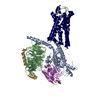
|
|---|---|
| 1 |
|
- Components
Components
-Guanine nucleotide-binding protein ... , 3 types, 3 molecules ABG
| #1: Protein | Mass: 28907.684 Da / Num. of mol.: 1 / Mutation: engineered with "miniGs" mutations Source method: isolated from a genetically manipulated source Source: (gene. exp.)  Homo sapiens (human) / Gene: GNAS, GNAS1, GSP / Production host: Homo sapiens (human) / Gene: GNAS, GNAS1, GSP / Production host:  Homo sapiens (human) / References: UniProt: P63092 Homo sapiens (human) / References: UniProt: P63092 |
|---|---|
| #2: Protein | Mass: 40786.566 Da / Num. of mol.: 1 Source method: isolated from a genetically manipulated source Source: (gene. exp.)  Homo sapiens (human) / Gene: GNB1 / Production host: Homo sapiens (human) / Gene: GNB1 / Production host:  Trichoplusia ni (cabbage looper) / References: UniProt: P62873 Trichoplusia ni (cabbage looper) / References: UniProt: P62873 |
| #3: Protein | Mass: 7563.750 Da / Num. of mol.: 1 Source method: isolated from a genetically manipulated source Source: (gene. exp.)  Homo sapiens (human) / Gene: GNG2 / Production host: Homo sapiens (human) / Gene: GNG2 / Production host:  Trichoplusia ni (cabbage looper) / References: UniProt: P59768 Trichoplusia ni (cabbage looper) / References: UniProt: P59768 |
-Antibody / Protein / Protein/peptide , 3 types, 3 molecules NRS
| #4: Antibody | Mass: 15398.067 Da / Num. of mol.: 1 Source method: isolated from a genetically manipulated source Source: (gene. exp.)   |
|---|---|
| #5: Protein | Mass: 47542.867 Da / Num. of mol.: 1 Source method: isolated from a genetically manipulated source Source: (gene. exp.)  Homo sapiens (human) / Gene: TACR1, NK1R, TAC1R / Production host: Homo sapiens (human) / Gene: TACR1, NK1R, TAC1R / Production host:  Homo sapiens (human) / References: UniProt: P25103 Homo sapiens (human) / References: UniProt: P25103 |
| #6: Protein/peptide | Mass: 1348.637 Da / Num. of mol.: 1 / Source method: obtained synthetically / Source: (synth.)  Homo sapiens (human) / References: UniProt: P20366 Homo sapiens (human) / References: UniProt: P20366 |
-Details
| Has ligand of interest | N |
|---|---|
| Has protein modification | Y |
-Experimental details
-Experiment
| Experiment | Method: ELECTRON MICROSCOPY |
|---|---|
| EM experiment | Aggregation state: PARTICLE / 3D reconstruction method: single particle reconstruction |
- Sample preparation
Sample preparation
| Component |
| ||||||||||||||||||||||||||||||||||||||||||
|---|---|---|---|---|---|---|---|---|---|---|---|---|---|---|---|---|---|---|---|---|---|---|---|---|---|---|---|---|---|---|---|---|---|---|---|---|---|---|---|---|---|---|---|
| Molecular weight | Experimental value: NO | ||||||||||||||||||||||||||||||||||||||||||
| Source (natural) |
| ||||||||||||||||||||||||||||||||||||||||||
| Source (recombinant) |
| ||||||||||||||||||||||||||||||||||||||||||
| Buffer solution | pH: 7.5 | ||||||||||||||||||||||||||||||||||||||||||
| Specimen | Embedding applied: NO / Shadowing applied: NO / Staining applied: NO / Vitrification applied: YES | ||||||||||||||||||||||||||||||||||||||||||
| Specimen support | Grid material: GOLD / Grid mesh size: 300 divisions/in. / Grid type: Quantifoil R1.2/1.3 | ||||||||||||||||||||||||||||||||||||||||||
| Vitrification | Instrument: FEI VITROBOT MARK IV / Cryogen name: ETHANE / Humidity: 100 % / Chamber temperature: 277 K |
- Electron microscopy imaging
Electron microscopy imaging
| Experimental equipment |  Model: Titan Krios / Image courtesy: FEI Company |
|---|---|
| Microscopy | Model: FEI TITAN KRIOS |
| Electron gun | Electron source:  FIELD EMISSION GUN / Accelerating voltage: 300 kV / Illumination mode: FLOOD BEAM FIELD EMISSION GUN / Accelerating voltage: 300 kV / Illumination mode: FLOOD BEAM |
| Electron lens | Mode: BRIGHT FIELD |
| Image recording | Average exposure time: 1.52 sec. / Electron dose: 49.4 e/Å2 / Film or detector model: GATAN K3 (6k x 4k) / Num. of real images: 3670 |
| EM imaging optics | Energyfilter name: GIF Bioquantum / Energyfilter slit width: 20 eV |
- Processing
Processing
| Software |
| ||||||||||||||||||||||||||||||||||||||||||||||||||
|---|---|---|---|---|---|---|---|---|---|---|---|---|---|---|---|---|---|---|---|---|---|---|---|---|---|---|---|---|---|---|---|---|---|---|---|---|---|---|---|---|---|---|---|---|---|---|---|---|---|---|---|
| EM software |
| ||||||||||||||||||||||||||||||||||||||||||||||||||
| CTF correction | Type: PHASE FLIPPING AND AMPLITUDE CORRECTION | ||||||||||||||||||||||||||||||||||||||||||||||||||
| Particle selection | Num. of particles selected: 4865341 | ||||||||||||||||||||||||||||||||||||||||||||||||||
| Symmetry | Point symmetry: C1 (asymmetric) | ||||||||||||||||||||||||||||||||||||||||||||||||||
| 3D reconstruction | Resolution: 3.1 Å / Resolution method: FSC 0.143 CUT-OFF / Num. of particles: 288659 / Symmetry type: POINT | ||||||||||||||||||||||||||||||||||||||||||||||||||
| Atomic model building | PDB-ID: 6HLP Accession code: 6HLP / Source name: PDB / Type: experimental model | ||||||||||||||||||||||||||||||||||||||||||||||||||
| Refinement | Cross valid method: NONE Stereochemistry target values: GeoStd + Monomer Library + CDL v1.2 | ||||||||||||||||||||||||||||||||||||||||||||||||||
| Displacement parameters | Biso mean: 64.04 Å2 | ||||||||||||||||||||||||||||||||||||||||||||||||||
| Refine LS restraints |
|
 Movie
Movie Controller
Controller





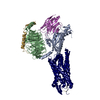
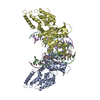
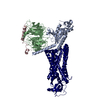
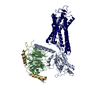
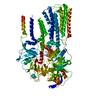
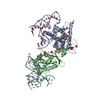

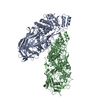
 PDBj
PDBj
























